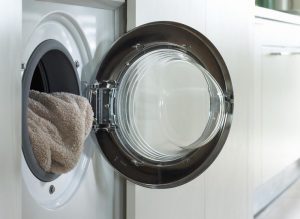Finding Your Lint Trap
Depending on the model and manufacturer of your washer, it can be tricky to find the lint trap. The best way to locate your lint trap is to consult your owner’s manual. This will detail where you can find the lint trap. If you can’t find the owner’s manual for your appliance, you can save a great deal of time and frustration by visiting the manufacturer website and looking at the options for downloading a manual. If this is not possible, you will need to go hunting for your trap. Some models have the trap on the top rim of the tub. You’ll need to slide your fingers along the drum to see if you can feel a screen that can be pulled out. Some washer models have a trap inside the center agitator; check for a removable agitator cover and look for a trap placed at the bottom where it is attached to the tub. Another common placement is a screen at the end of the drainage hose or near the water pump. This is usually a small screen, and you will need to remove the outer housing to access the filter.
Cleaning the Trap
Once you’ve found the lint trap, it is likely to be covered in a sticky amount of wet lint. This lint is usually coated with residues of detergent and fabric softener. You will need to use a small brush or paper towel to remove the lint from the screen mesh. If your trap has a removable screen, soak it for ten minutes in hot water to clear any remaining residue that could slow drainage, before you replace the trap.
To keep your washer working at its best, you should clean the lint filter at least every three months. This will help to improve drainage and reduce redeposits of lint that can appear on clothing.
What if There’s No Trap
Some newer washers don’t actually use a trap. Instead, these appliances rely on a pump to carry excess lint out of the machine. Front loading and high-efficiency appliances often have a pump rather than a lint trap. This doesn’t mean that you can assume that everything is taken care of. These types of appliances still need a little care and attention to ensure optimum performance. Since these models use less water compared to a standard washer, it is usually recommended to run a cleaning cycle periodically. Running an empty load each month can help to avoid lint clogging up and creating problems. This type of cycle can help to keep your washer clean, control odors and flush away any lint.
If you start to see lint, your water pump may have become clogged. When this occurs, the rinse water and wash drain slowly, and deposits are left on your clothing. Most models of front-loading washers feature a small door at the bottom of the machine. This can be opened, allowing you to remove any coins, lint, buttons or even socks that have become caught in the pump filter.
The lint trap is just one of the common washing machine repair issues that you may encounter. Educating yourself on some of the common issues will help you to tackle some of the simple repair projects, but for the reassurance of a long-term solution, you should consult a professional home appliance repair technician.
For help with any washing machine repair issues, you should speak to a professional appliance repair service.
